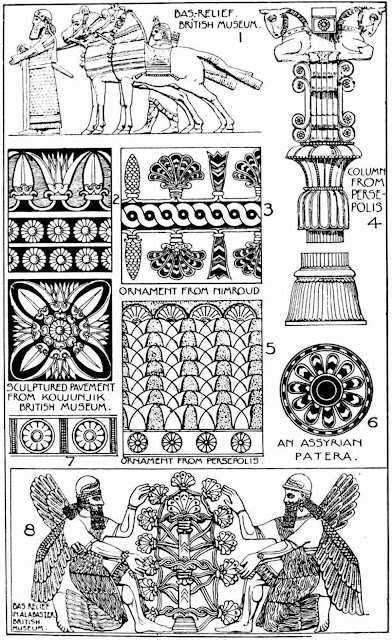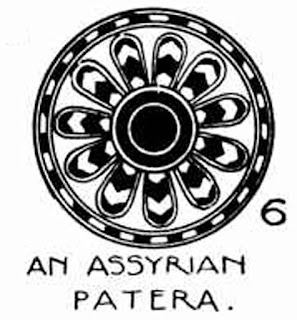_ _ _ _ _ _
Еxcerpt from the book: A Manual of HISTORIC ORNAMENT TREATING UPON THE EVOLUTION, TRADITION AND DEVELOPMENT OF ARCHITECTURE AND OTHER APPLIED ARTS. PREPARED FOR THE USE OF STUDENTS AND CRAFTSMEN.
BY RICHARD GLAZIER, Associate of the Royal Institute of British Architects; Head Master of the Municipal School of Art, Manchester, LONDON: 1899
_ _ _ _ _ _
Originally one nation, they became divided, and the younger Assyria in the north became the most powerful empire of that period under Tiglath Pileser I., B.C. 1100, Ashur-nasir-pal, B.C. 885-60, Shalmaneser II., B.C. 860-25, Tiglath-Pileser III., B.C. 745-27, the Great Sargon, B.C., 722-705, Sennacherib, B.C. 705-681, Esarhaddon, B.C. 681-668, and Ashur-ban-pal, B.C. 668-626.
In B.C. 609 the capital, Nineveh, was destroyed by Cyaxares the Mede, and Babylon arose again to power under Nebuchadnezzar, B.C. 604-562; this city was destroyed by Cyrus the Persian, B.C. 539.
Assyrian art with its racial influences, religious beliefs and climatic conditions, differs in a remarkable degree from Egyptian art. Though stone is found in Assyria, the great cities were built of brick, no doubt owing to the fact of the arts and civilization coming from Chaldea, where stone was scarce and clay plentiful. Both at Babylon in Chaldea, and Nineveh in Assyria, the traditional type of building was rectangular, with arched openings and vaults, built of sun-dried bricks; the lower part of the wall was covered with large alabaster slabs, carved in low relief with scenes representing the King and his warriors engaged in hunting or fighting (fig. 1).
The upper part of the wall was in enameled brick or in coloured stucco, with details of the Lotus and Bud, together with the rosette, which was often carried round the archivolt. The representation of the industrial arts and the pursuits of agriculture, which is so admirably illustrated upon the Egyptian reliefs, is entirely absent in Assyria.
The enameled bricks of Chaldea, were modelled in low relief with enamels of turquoise blue, yellow, white and black, of fine quality and colour, one splendid example is the Frieze of Archers from the Palace of Susa.
The enameled bricks of Assyria were usually flat, or modelled but slightly, and the enamels were less pure. The external walls were similar to the internal ones, but with larger friezes and bolder reliefs, and usually with religious subjects (fig. 9).
The portals of the doors were enriched with colossal winged and human headed bulls, of alabaster, finely carved in relief. Typical examples of Assyrian ornament are the Lotus and Bud (figs. 2 and 3), the Patera or Rosette (figs. 6 and 7), and the Horn or Tree of Life (fig 8).
The Lotus enrichment shows Egyptian influence, and only came into use during the 7th century B.C., when intercourse between the two nations was established. It is differentiated from the Egyptian lotus by its vigorous growth and curved profile, and the geometrical form of the calyx of the flower and bud (fig. 2).
The Anthemion or Hom, with its alternate bud and fir-cone, and with strong lateral markings is beautiful in line and proportion of mass (fig. 3). The Hom is frequently used as a flower on the sacred tree, a form of enrichment that influenced much of the later Persian and Sicilian textile fabrics.

















Social Plugin